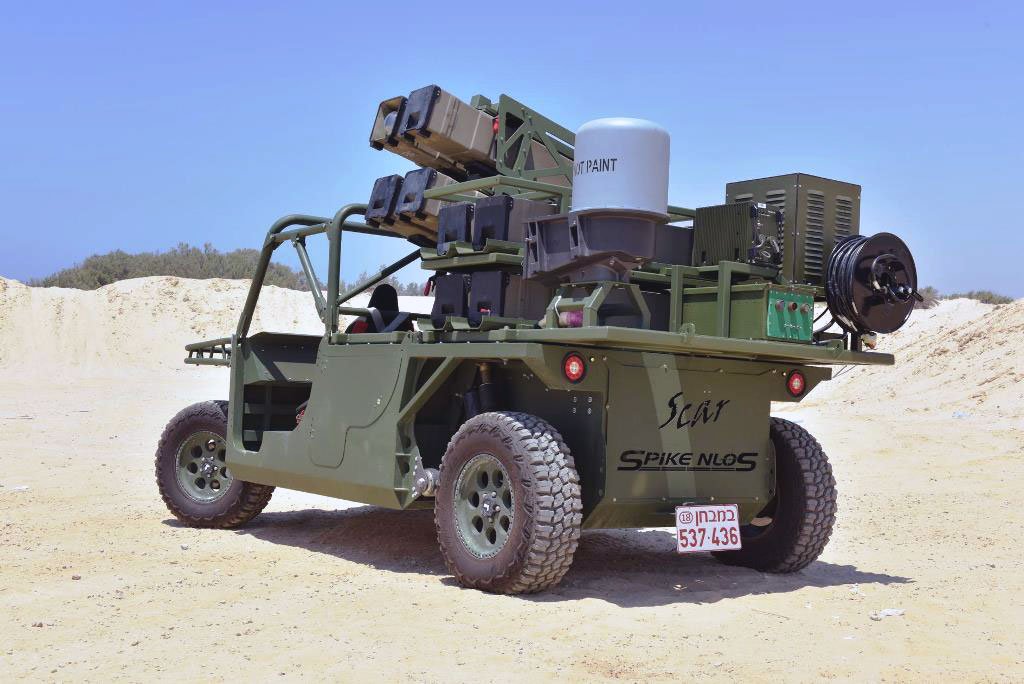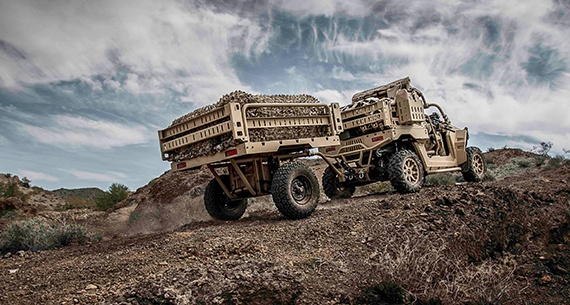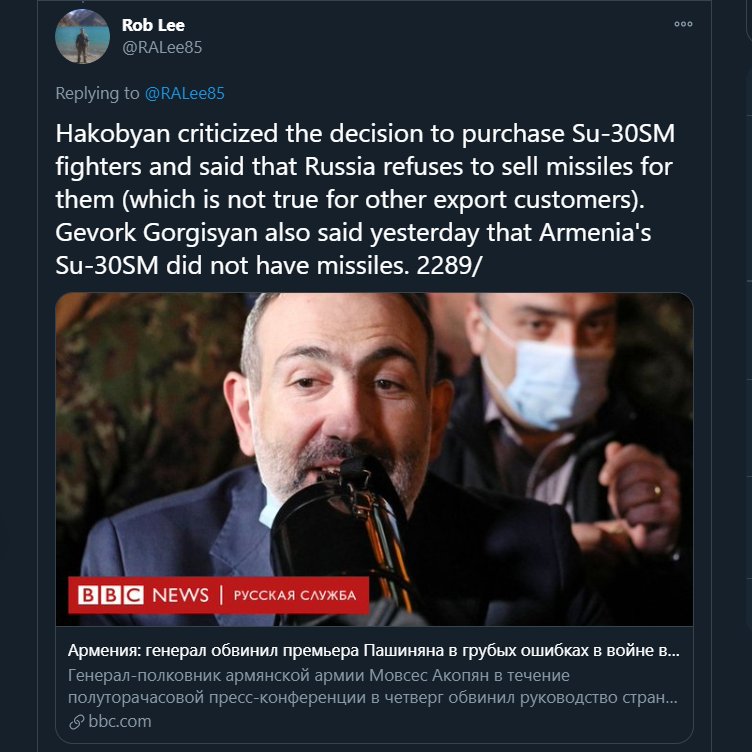
Interesting interview with Marat Gabidullin, a former Wagner contractor who fought in Syria and was wounded in Palmyra in 2016. Before joining Wagner, he graduated from RGVVDKU, served in the VDV, and was imprisoned in 1997 as a gang member. 53/
meduza.io/en/feature/202…

meduza.io/en/feature/202…
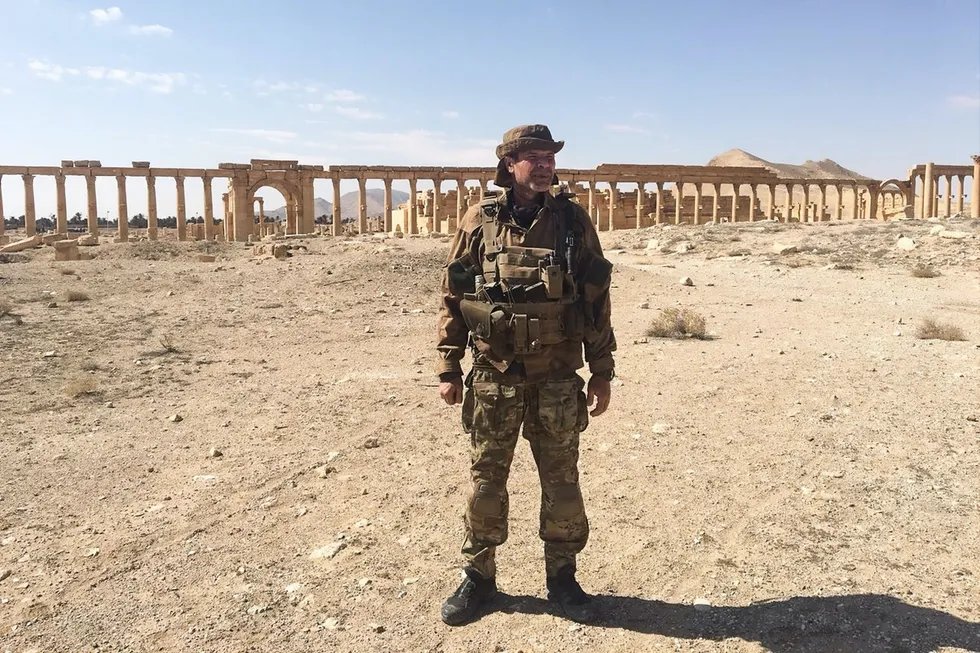
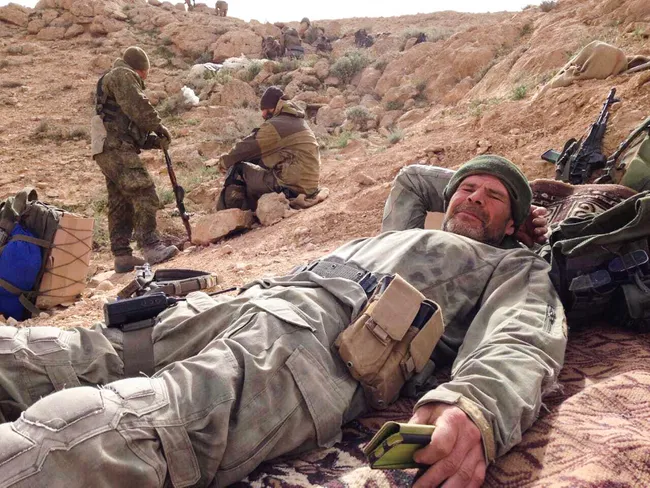
Gabidullin wrote a memoir of his time in Wagner that is supposedly non-fiction though it changes the names of the people involved. However, Prigozhin didn't approve of this publication and today he has apparently withdrawn the book from publication. 2/
snob.ru/news/napisavsh…
snob.ru/news/napisavsh…
Gabidullin says he showed Prigozhin the book but was told to delay its publication. After the constitution was changed, allowing Putin to serve for longer, he says he was told that the book's publication would have to be delayed even longer. 3/
meduza.io/feature/2020/1…

meduza.io/feature/2020/1…
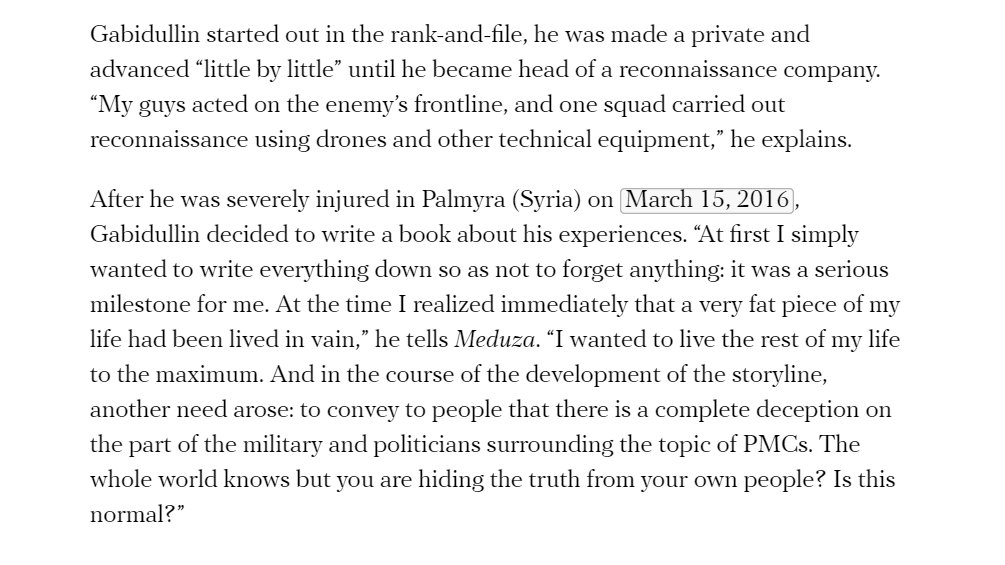

He says that the infamous video of 4 Wagner private military contractors torturing and murdering a Syrian with a sledgehammer from 2017 was ordered personally by Dmitry Utkin, the head of Wagner, and that he also ordered them to videotape it. 4/ 
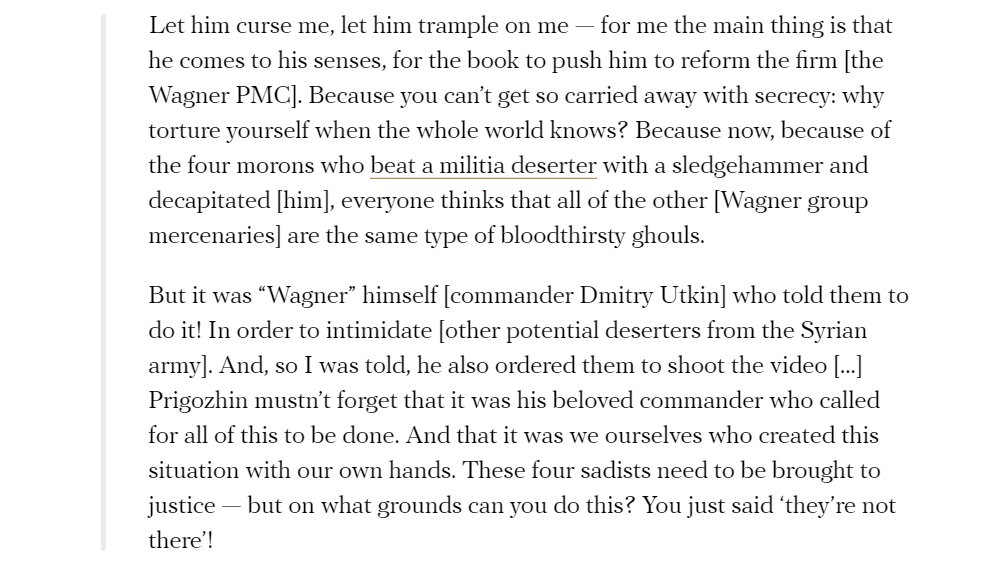
He also says that Wagner is increasingly recruiting people without combat experience and with leaders who are less capable than those who fought in Syria in 2015-2017. Some of the private military contractors arrested in Minsk in August lacked serious military backgrounds too. 5/ 
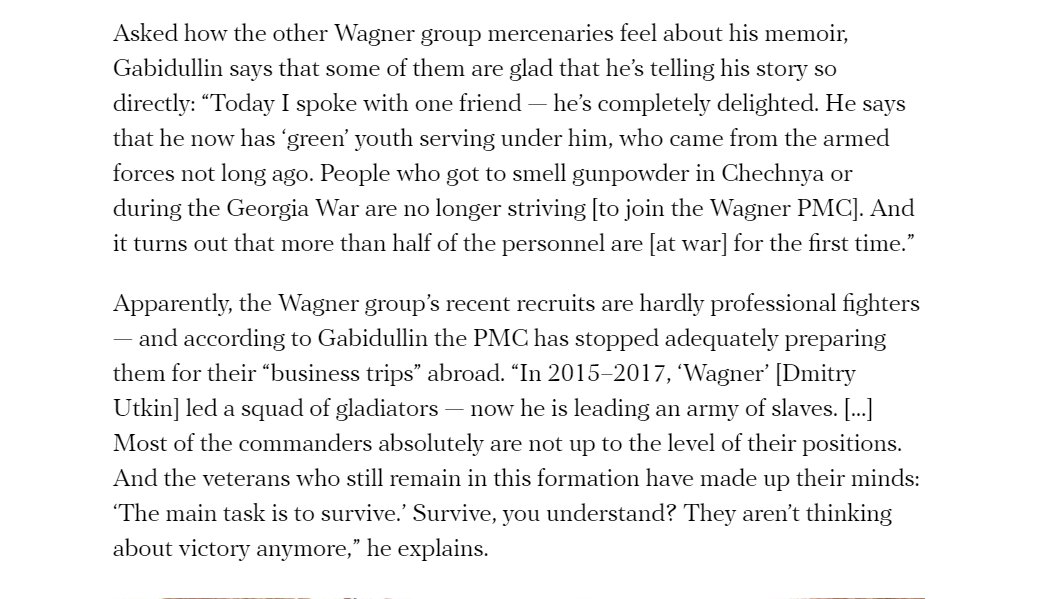
We haven't heard much about Wagner causalities in Libya recently, but they likely sustained some during the battle of Tripoli. He alleges that Wagner commanders view it more as a business, which means asking for fewer resources for their fighters and taking more of the profit. 6/ 
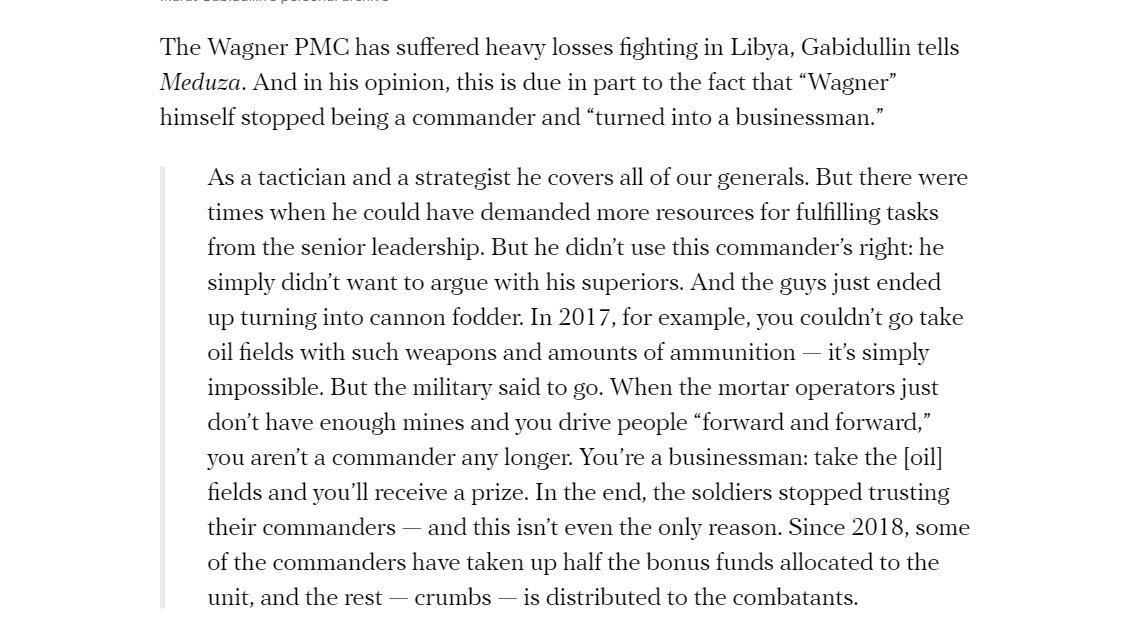
These kind of anecdotes point to why he claims more experienced fighters may no longer be interested in taking on Wagner contracts. 7/ 
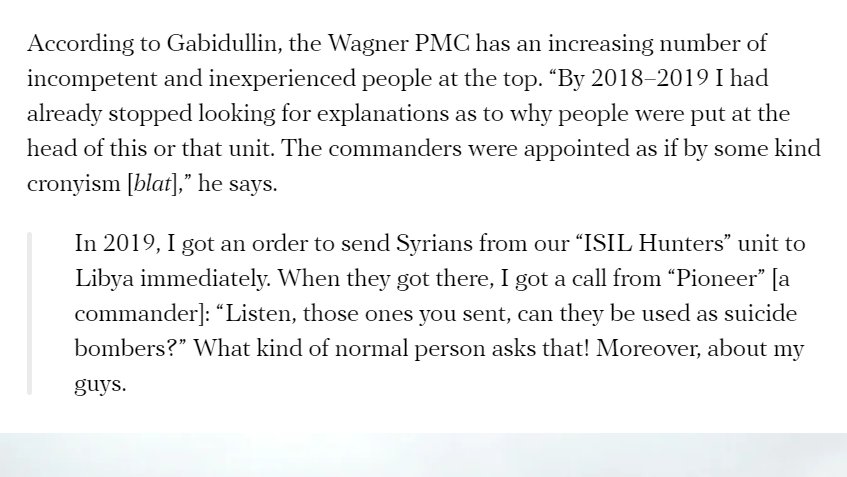
One of his main points is that the book is necessary because he believes Wagner needs to be reformed and he believes Prigozhin doesn't fully understand some of its problems or what was going on in Syria. 8/ 
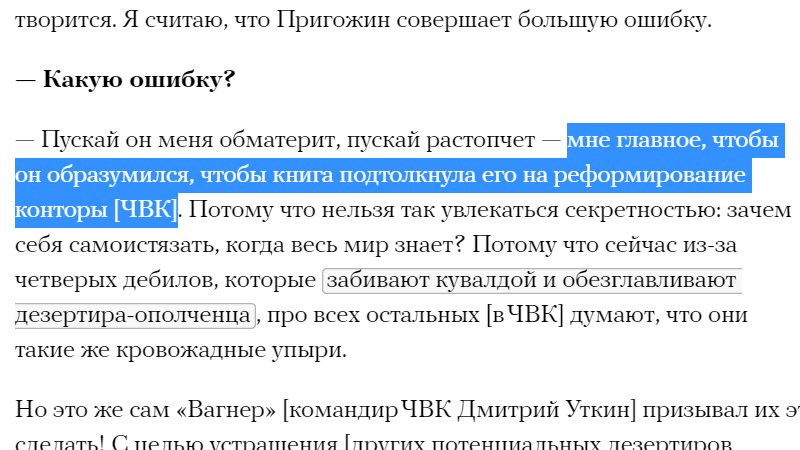
He alleges that people were stealing from Prigozhin (including his closest assistants), including an anecdote that support personnel were using kneepads for gardening not tactical ones, and that they procured outdated and decommissioned BRDM-2 vehicles with limited upgrades. 9/ 

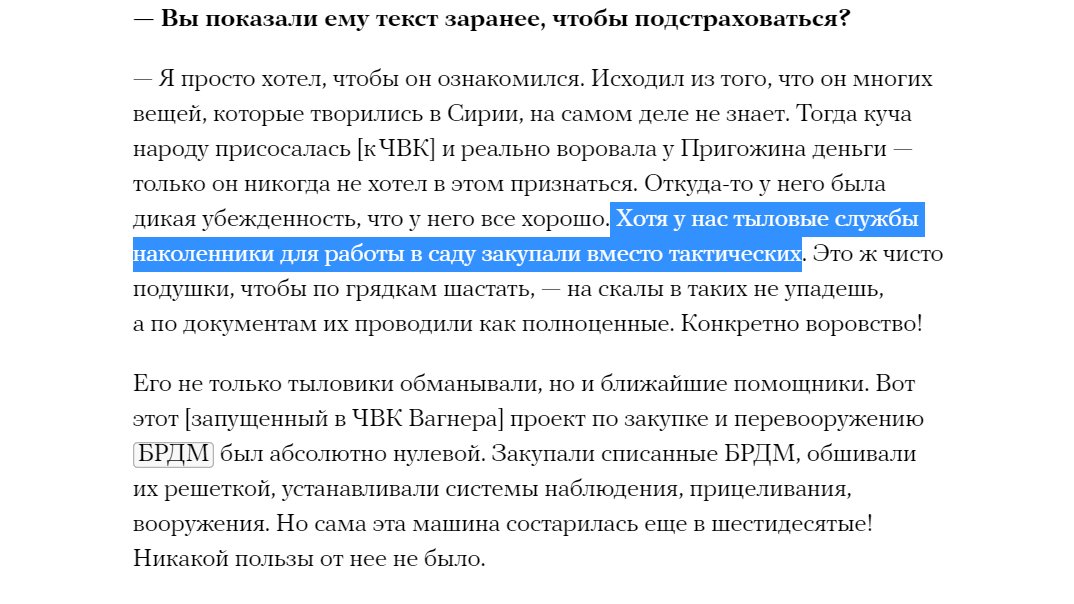
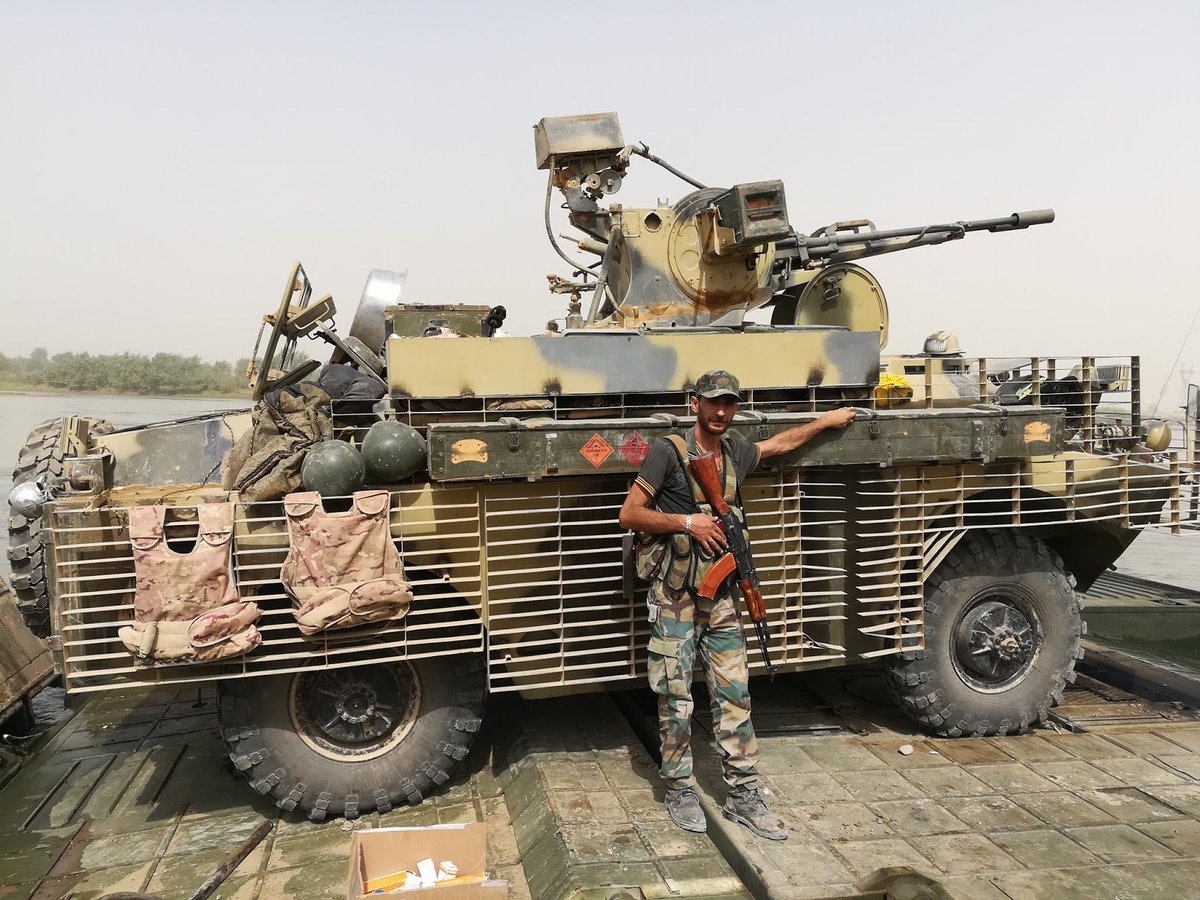
These BRDM-2 with RPG-screens and ZU-23-2 were quite well known. He argues that these were outdated and that Wagner should have bought more modern equipment for its fighters, and that Prigozhin didn't know this. 10/
Gabidullin said that he was wounded in March 2016 in Palmyra. Even though his contract with Evro Polis didn't mention anything about medical care, he was treated at the Russian military Vishnevsky hospital and then at the Sogaz clinic in St Petersburg. 11/
Another Wagner private military contractor, Vladimir Skopinov, who was killed in Libya in January 2020 was also treated at the Vishnevsky hospital. 12/
https://twitter.com/RALee85/status/1273621700496830466
He alleges that, since 2017, some Wagner contractors have negotiated with their company commanders for awards, even if they never see combat. He also implies that some commanders never go the front, though he says this also happens in the military. 13/ 
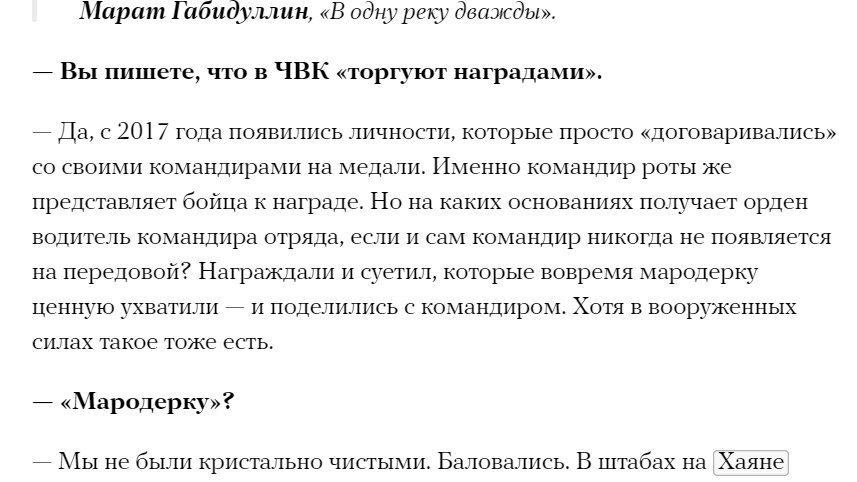
He also alleges that Wagner contractors took ancient stones from Palmyra and kept them at one of the oil refineries they protected and one of their bases, including part of one of the columns. Though he says this wasn't common. 14/ 
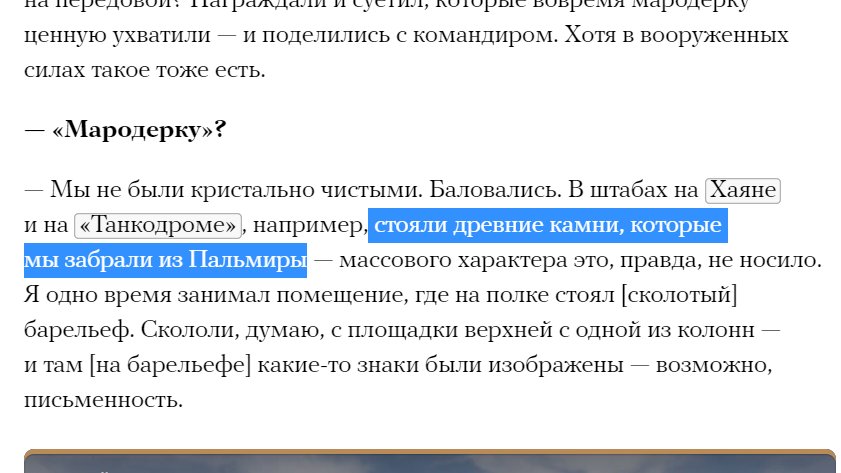
He claims that Wagner's leaders never considered that Turkey might become involved in Libya, and that the Libya mission was organized by idiots. 15/ 
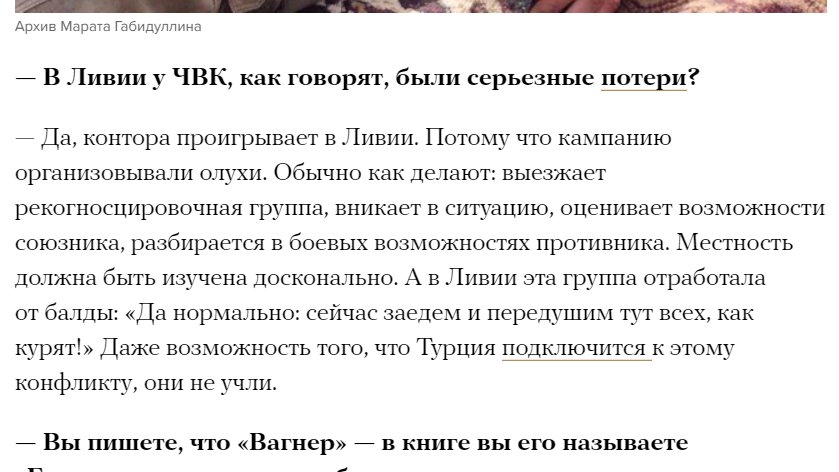
He says that some commanders have been taking half the bonuses for their units and specifically mentions the Serbian commander who extorted members of the international platoon. He also says the commander of the unit during the operation in Ghouta had no combat experience. 16/ 
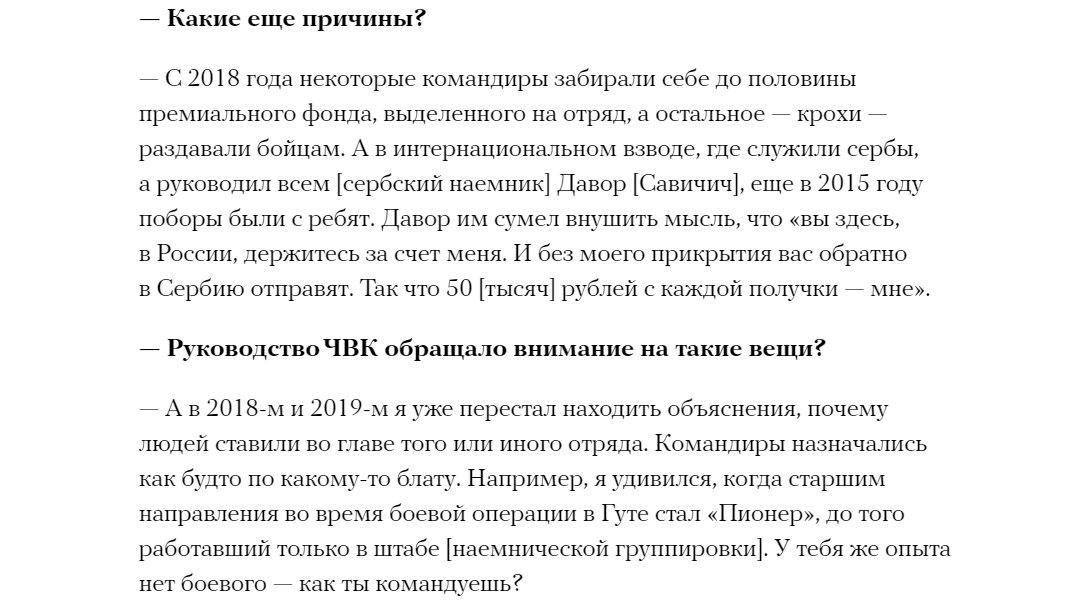
He mentions the ISIS Hunters, which he says is entirely composed of Syrians. He says he trained them in 2018-2019, but before that he says they mostly only did PR stunts and didn't take part in any real fighting. 17/ 

He says that the ISIS Hunters took photos of themselves after the 2nd Palmyra battle after Wagner had already seized the airfield. They slowly began to take greater part in combat and then conducted operations on their own before taking "terrible losses" on the Euphrates. 18/ 
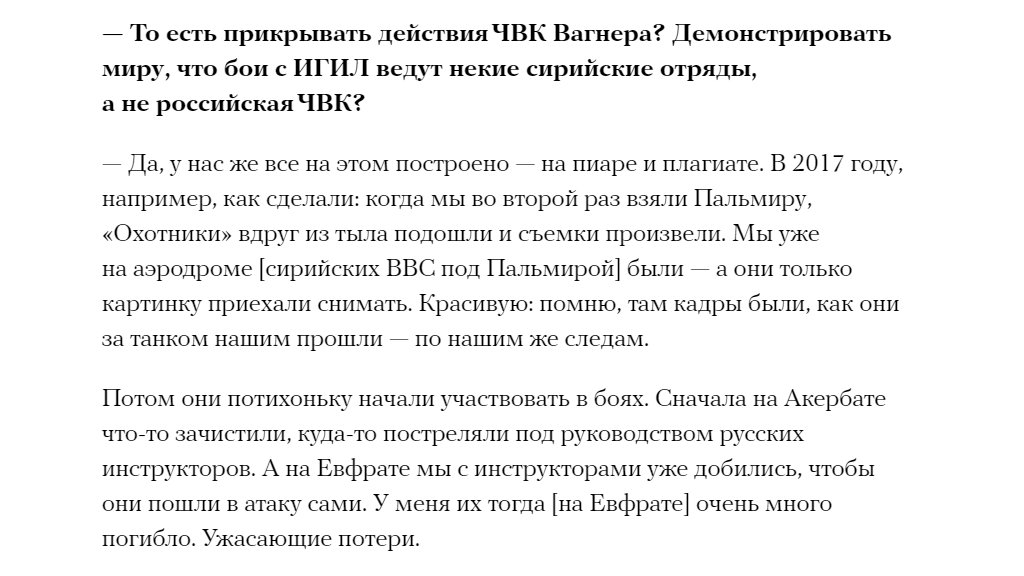
When asked which was his worst battle, he said the fight with US forces near Deir ez-Zor on February 8, 2018,
"Of course, on the Euphrates. Because I felt just, helpless". He said they couldn't see the enemy because they were facing US helicopters (Apaches). 19/
"Of course, on the Euphrates. Because I felt just, helpless". He said they couldn't see the enemy because they were facing US helicopters (Apaches). 19/
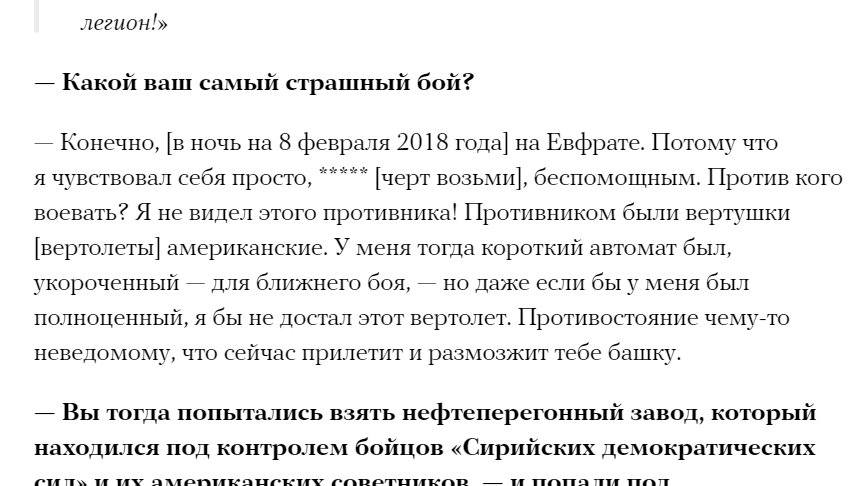
When asked who authorized the mission, Prigozhin or the Russian military, Gabidullin said he didn't know but said that none of the people in a position to stop it told Prigozhin "you can't do that". 20/ 
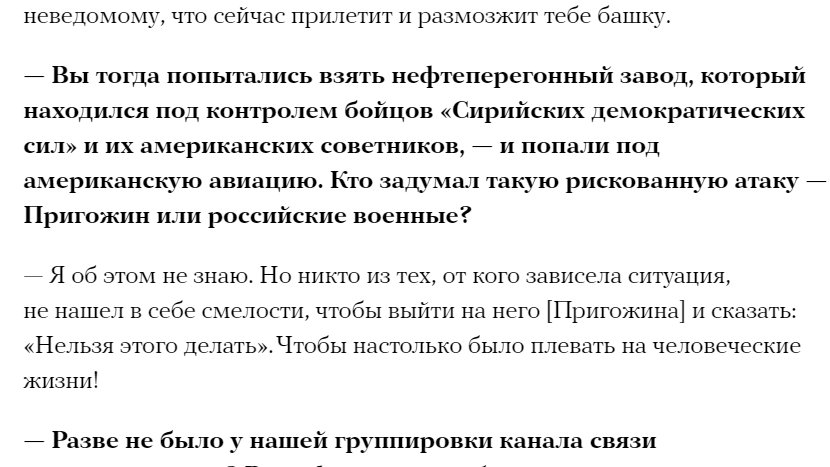
He said the Russian group commander (i.e. military) was in constant contact with the Americans, who pressed him to admit these were Russians attacking, but he refused and said "there are no Russians there." Gabidullin wonders if it would have turned out differently if he had. 21/ 
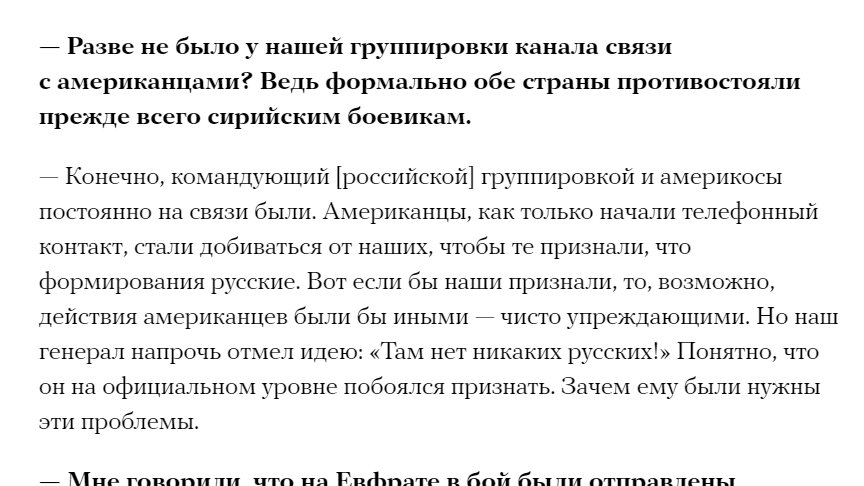
From the book, "'Martin' walked away from the burning tank. Someone was groaning on the ground...a fighter lay face down. Martin turned him over—he had no face" "The 1st clash between America and Russia in contemporary history didn't end in the favor of the Russian legionnaires." 
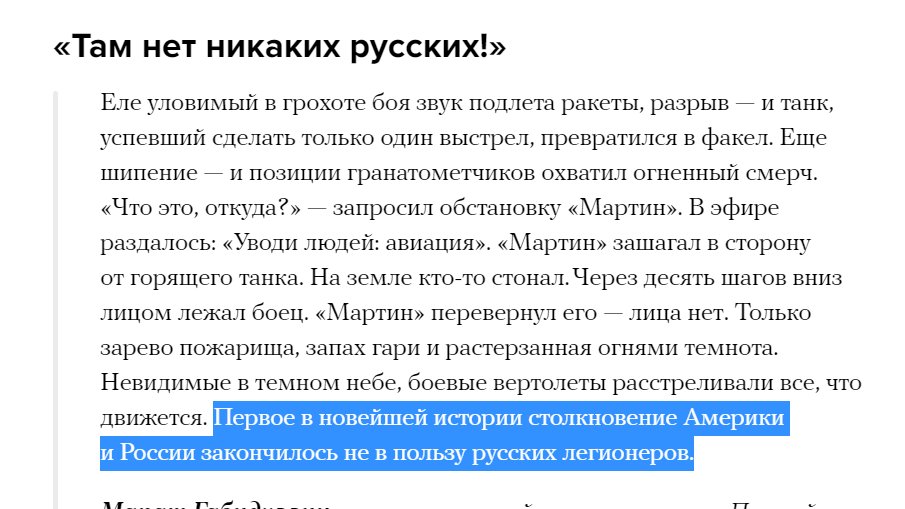
More from the passage about the Wagner firefight with US forces in 2018. It says a tank fired once and was then struck by a missile followed by an RPG team that was struck and engulfed in flames. "Invisible in the dark sky, the attack helicopters fired at anything that moved" 23/ 
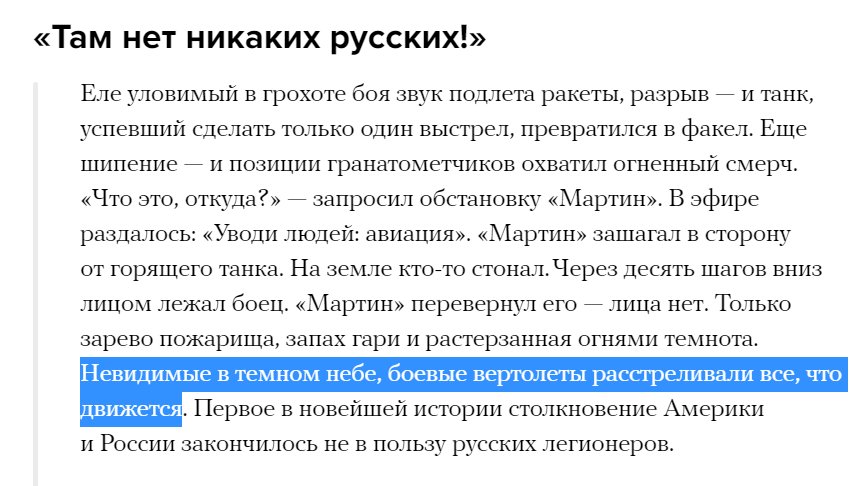
Gabidullin said that a group of ISIS prisoners fought on behalf of SAA/Wagner forces on Feb 7-8. He said ISIS prisoners were interrogated poorly by Wagner members who were former cops who interrogated them as if they were investigating a crime, not as intelligence officers. 24/ 
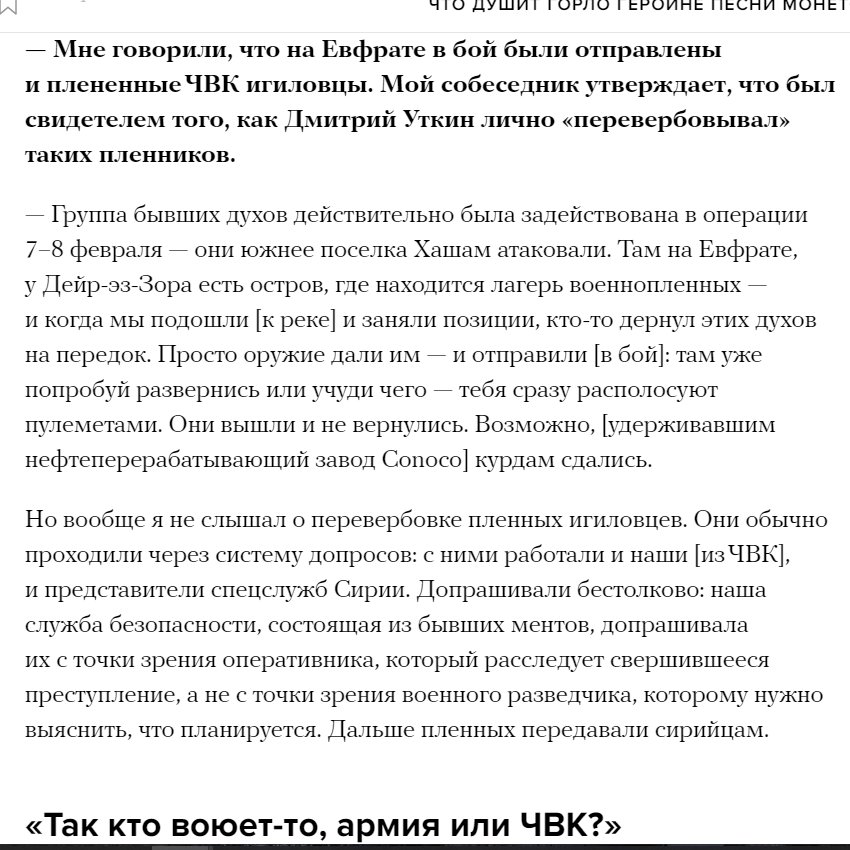
I've seen this sentiment expressed before by other Russian private military contractors. Even though they did much of the fighting in Syria, they publicly receive none of the credit, which is often directed to the Russian military, creating friction between the two. 25/ 

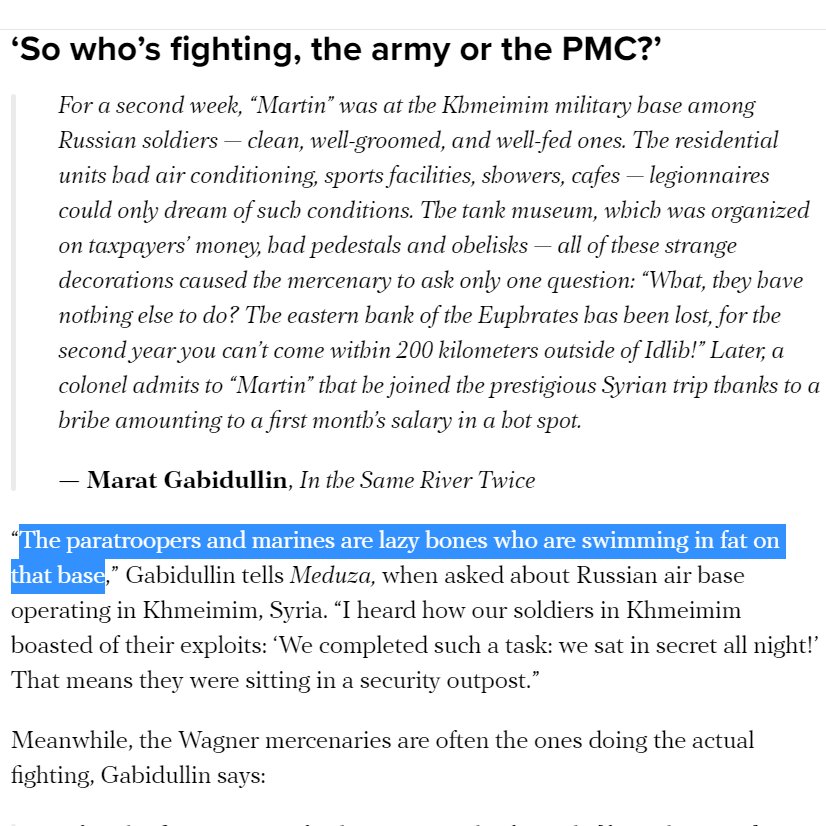
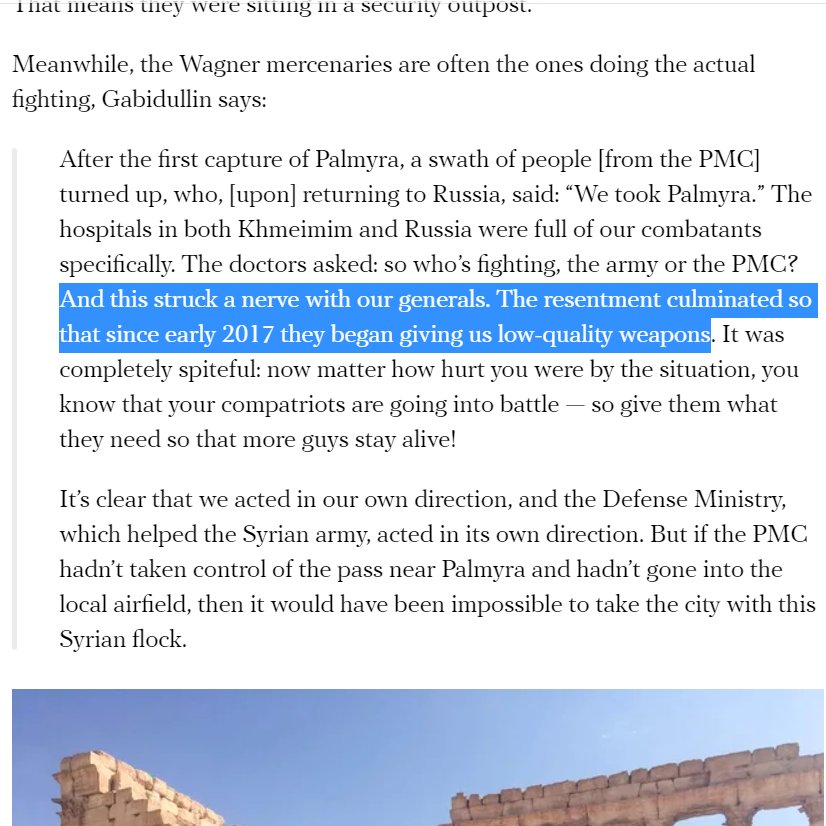
He criticizes RuSOF saying that GRU spetsnaz mostly escorted leaders but did few independent ops. He said SSO worked at the front and its sniper pairs were lethal in Aleppo but underperformed as a unit because they did few raids/ambushes and didn't go into the enemy's rear. 26/ 
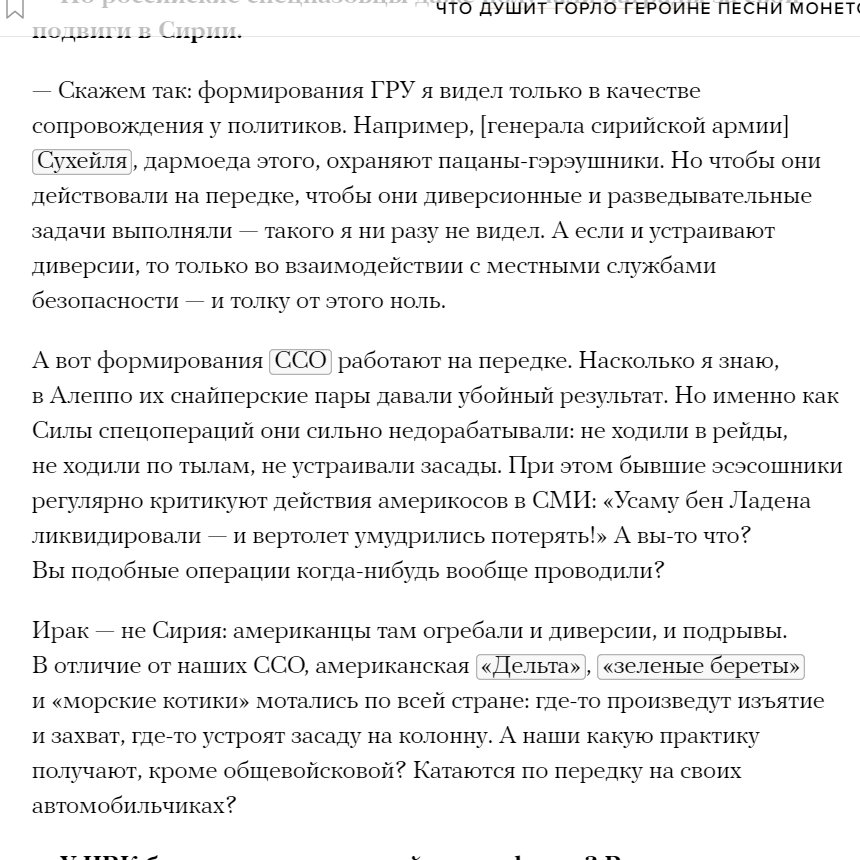
He says that former SSO specialists go on TV and criticize US SOF, but he said CAG, Green Berets, and SEALs operated across Iraq during the war, conducting ambushes on convoys, seizing positions, and other traditional SOF missions, which Russian SOF didn't do in Syria. 27/ 
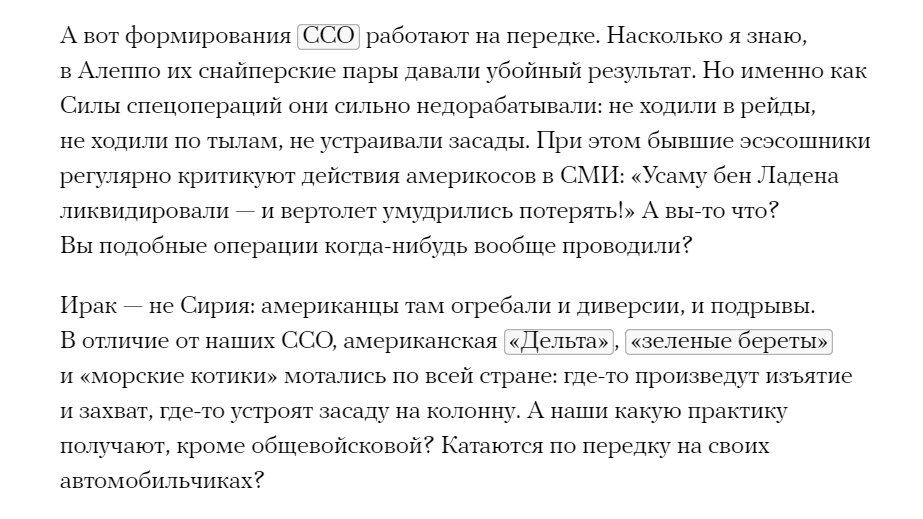
He criticized the quality of the SAA (many Russian veterans have as well) and said that Russian officers struggled to get them to press the attack. He also said that Suheil al-Hassan worked with Wagner in Aqerbat, and put on a show of taking the city after Wagner cleared it. 28/ 


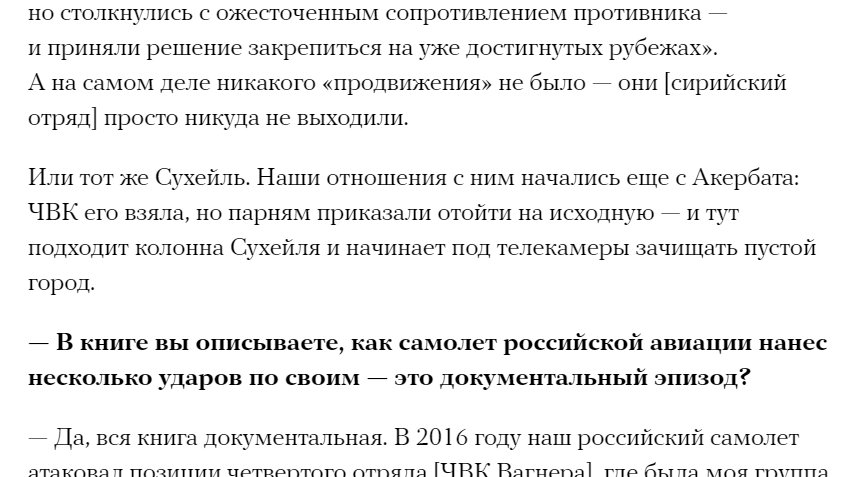
Interesting anecdote about a friendly fire incident that wounded Andrei Bogatov, the detachment commander. In the Russian version, he says that the Wagner fighters rushed to T4 airbase to find the pilot who killed their colleagues, but the plane took off from Khmeimim. 29/ 

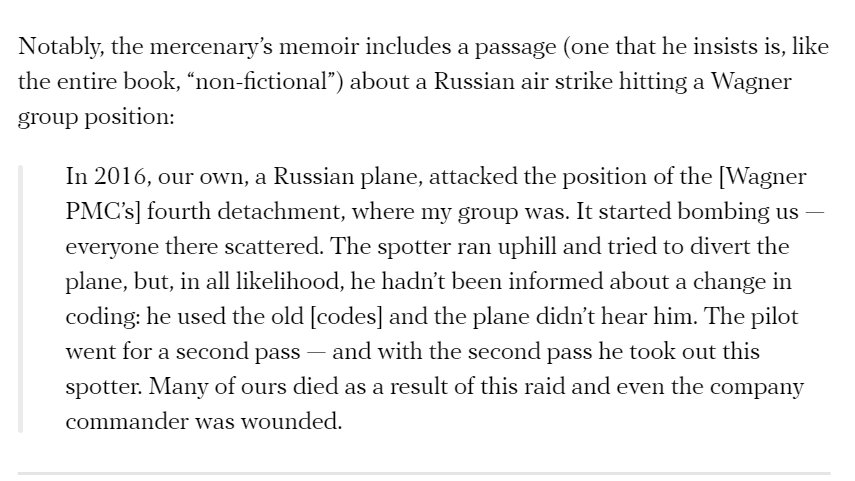
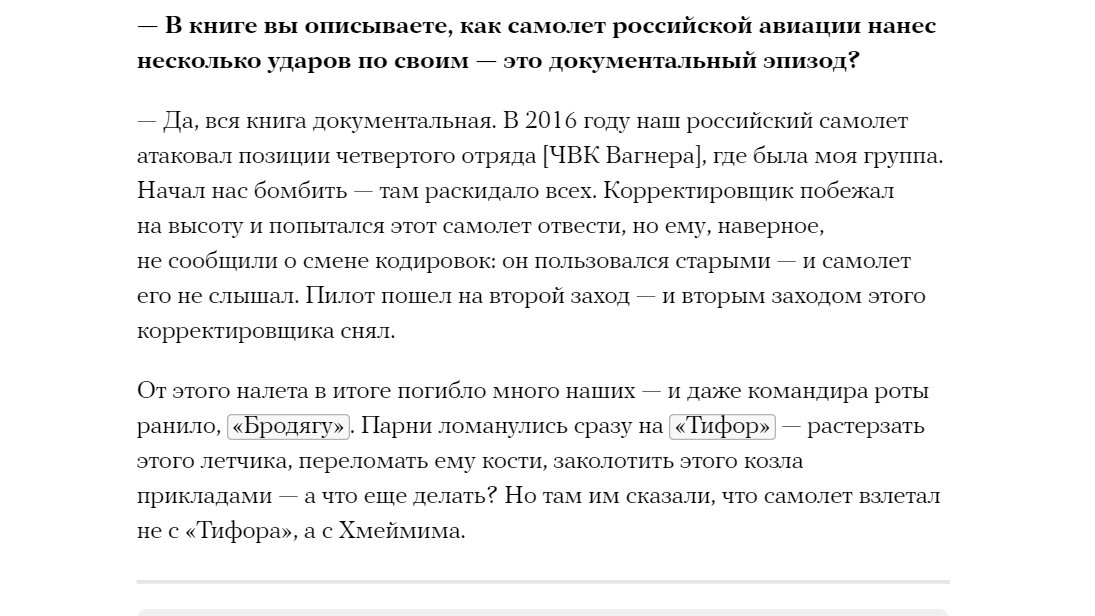
He said this area, which is controlled by militants, is a "thorn in the side of our military - something they don't want to admit." He said ISIS operates from there, and occasionally moves beyond as when they emplaced an IED that killed Russian Maj. Gen. Vyacheslav Gladkikh. 30/ 

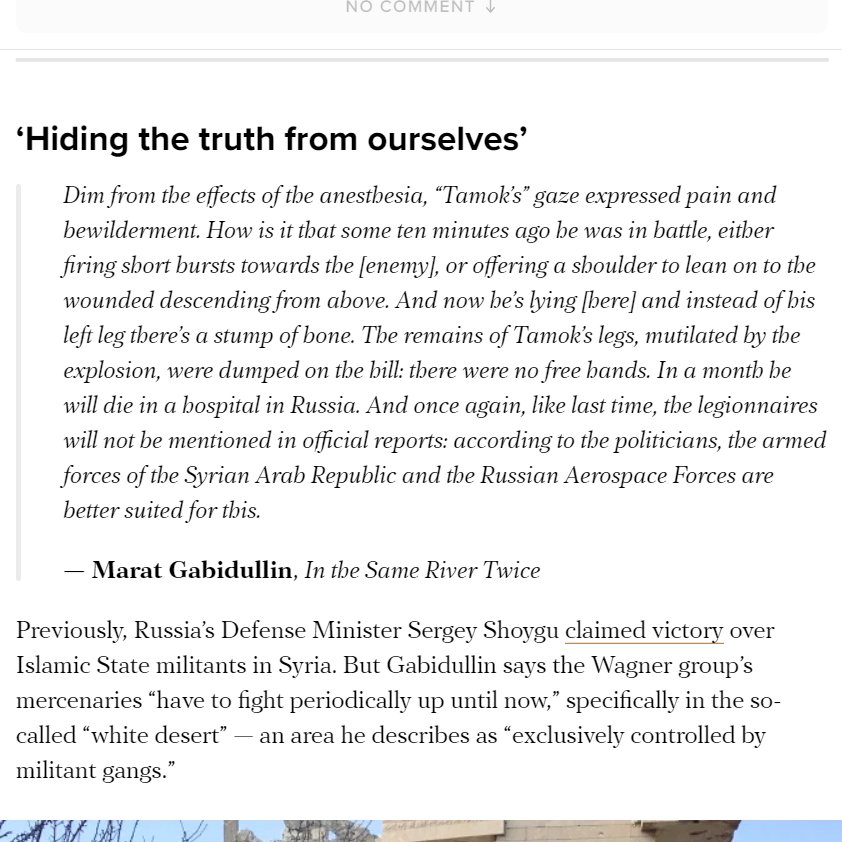
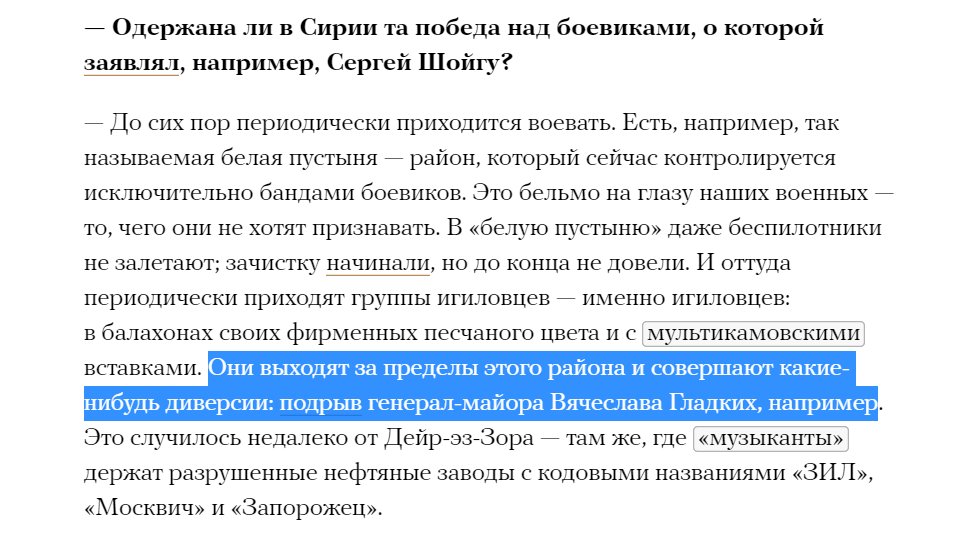
Some final points from the interview. He again points out his frustration that Russia, like the Soviet Union with its soldiers, won't acknowledge the deaths of private military contractors, including the Russian Foreign Ministry's spokeswoman and prominent TV pundits. 31/ 



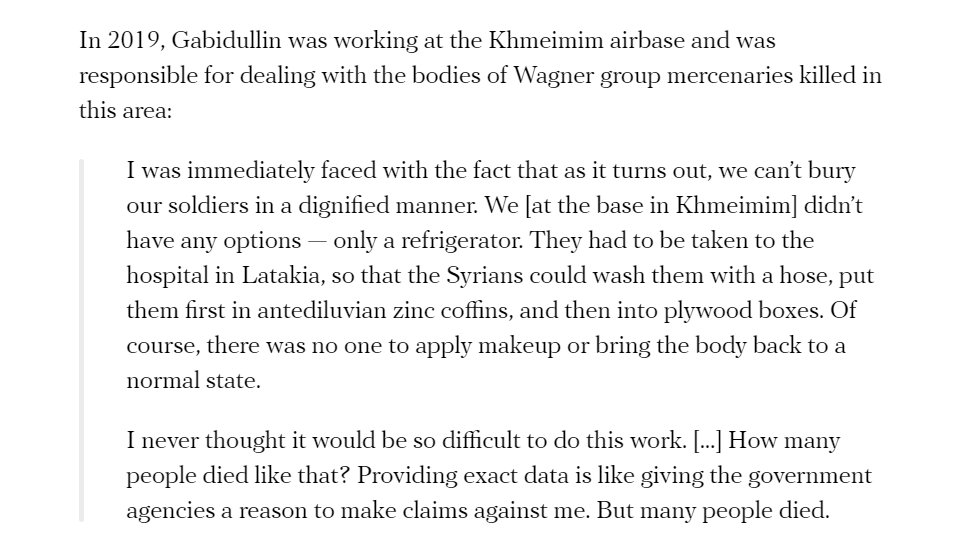
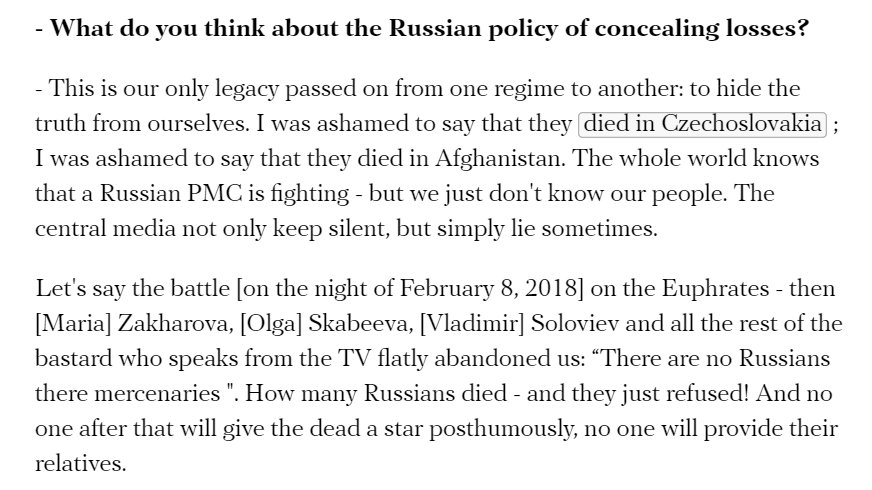
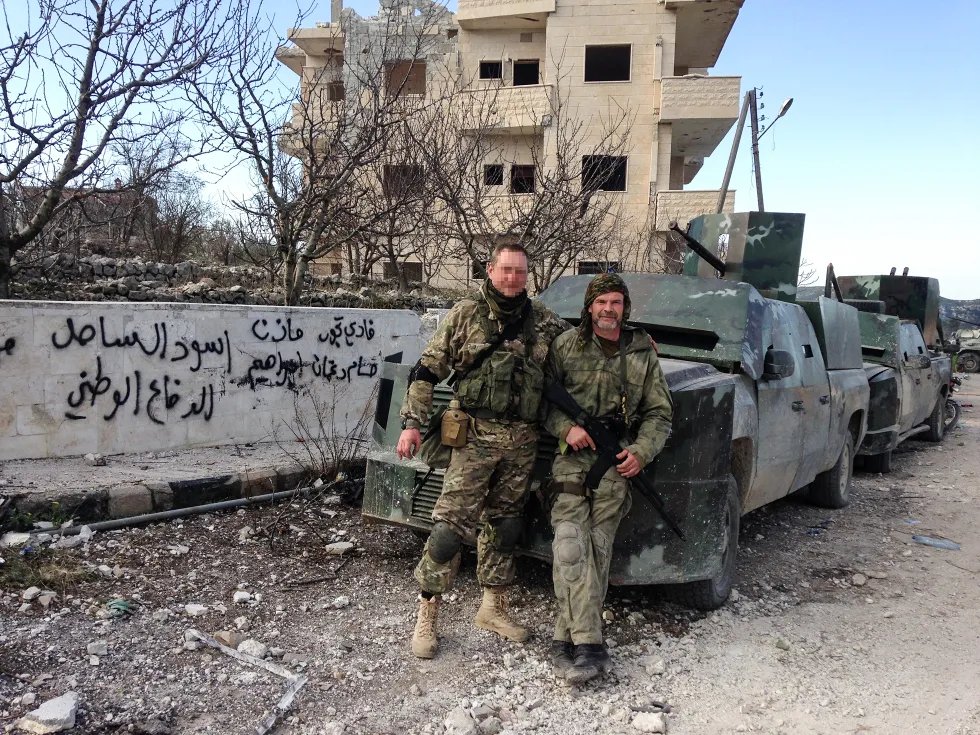
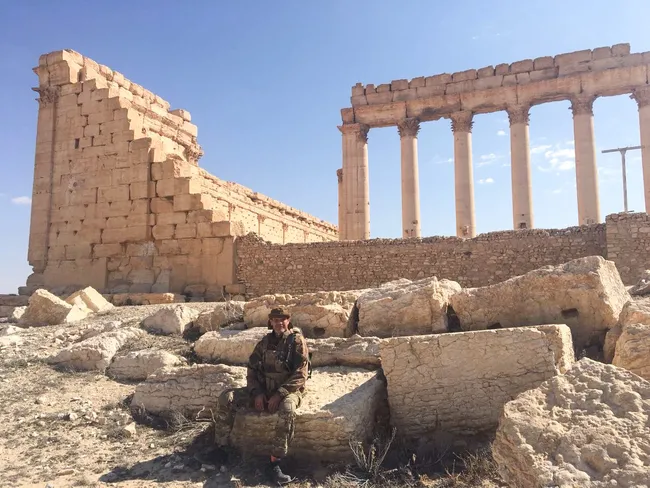
The RSOTM Telegram channel commented on the article and criticized the account. But they’re main point was that most of this was not new or a secret, which is true and why the account seemed genuine. This includes losses, Palmyra, SAA flaws, etc. 32/
t.me/grey_zone/6195



t.me/grey_zone/6195
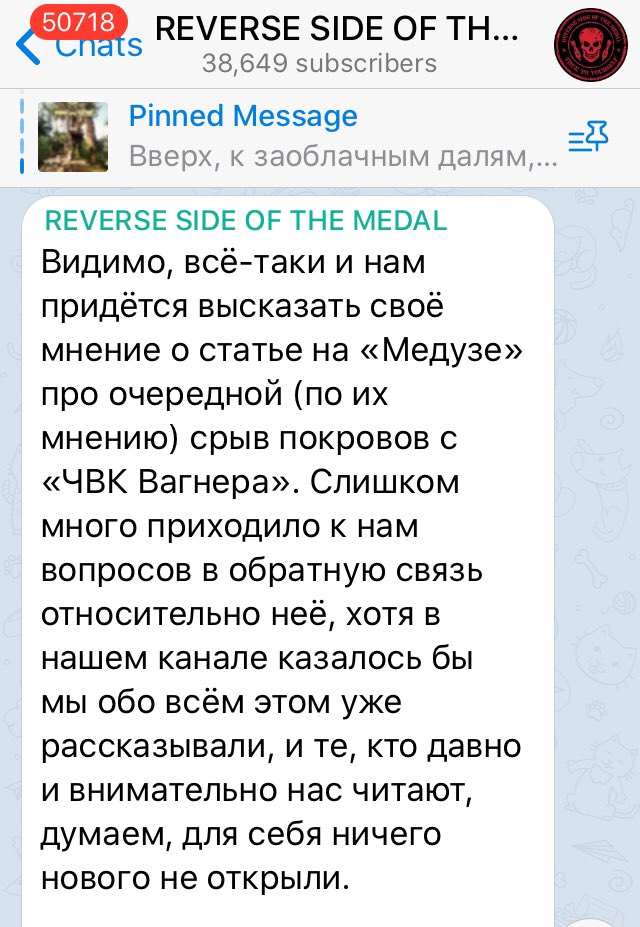
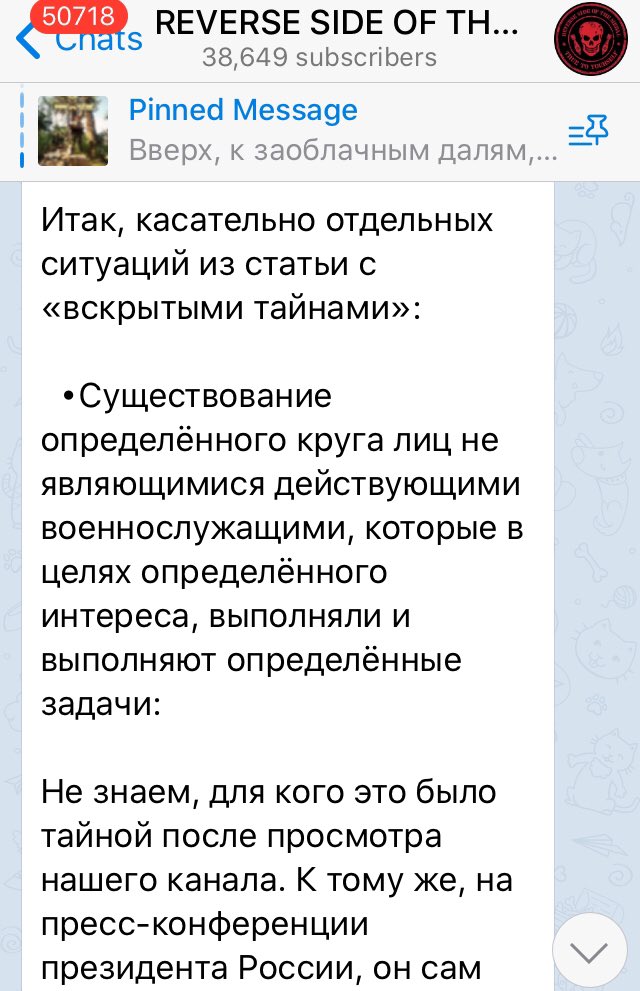
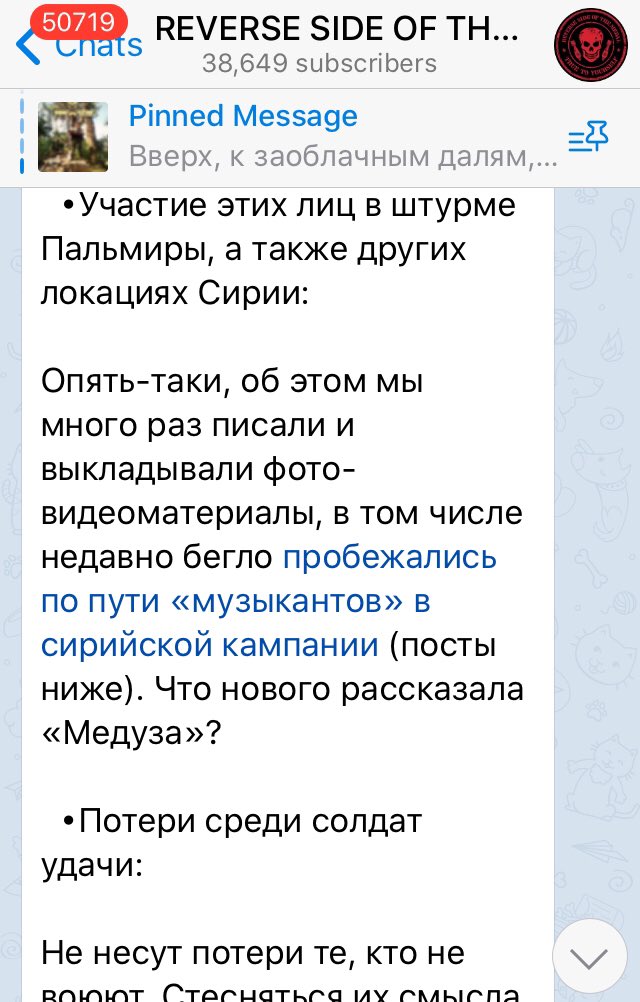
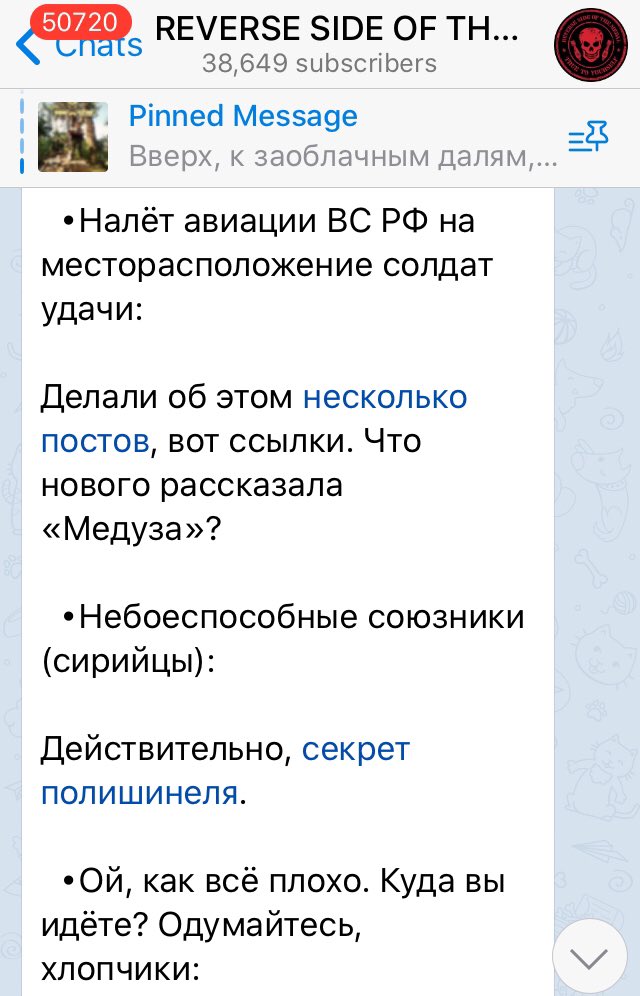
they have criticized the government for not acknowledging the deaths from SSO and PMCs in Syria too. They also reminded of an earlier post by them about the friendly fire incident with a Russian Su-25. The photos show a damaged Wagner Vystrel vehicle. 33/
t.me/grey_zone/1811



t.me/grey_zone/1811
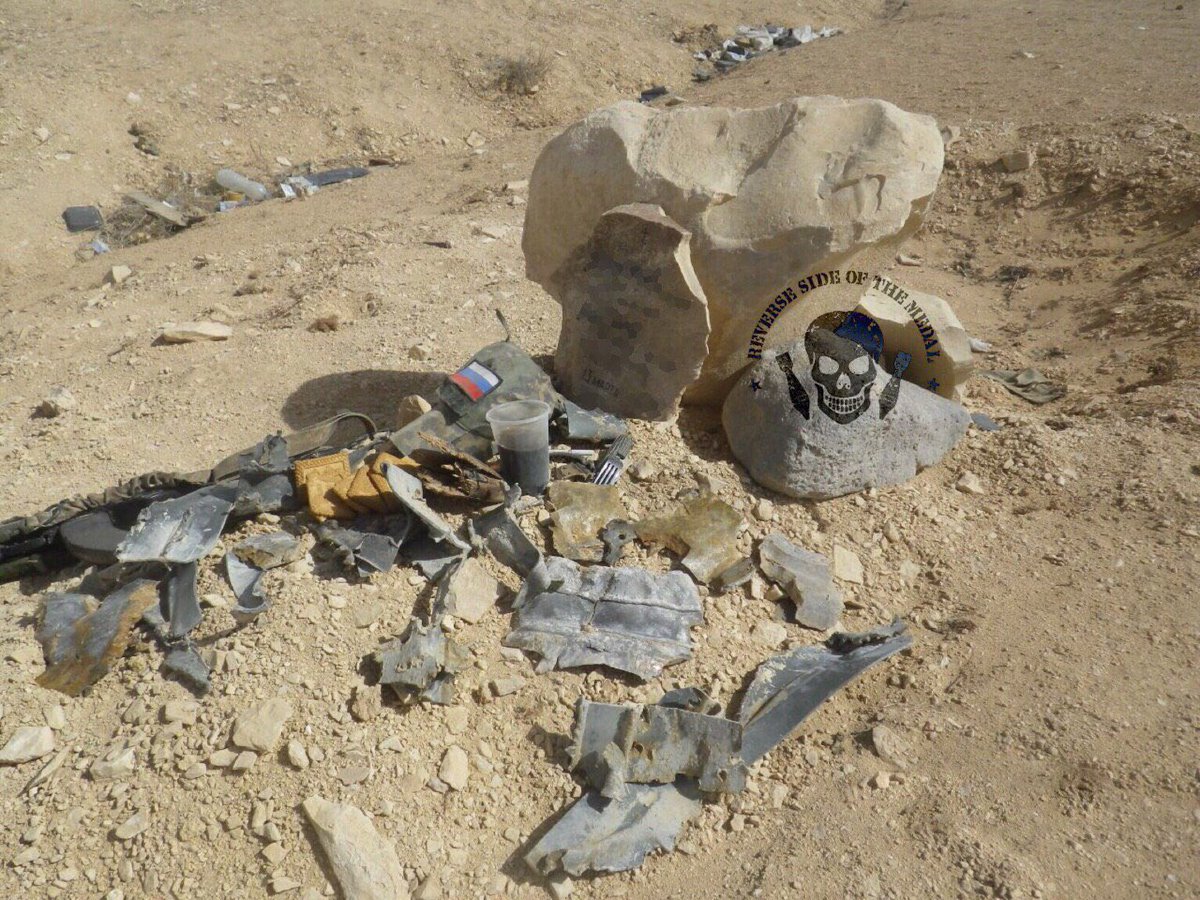
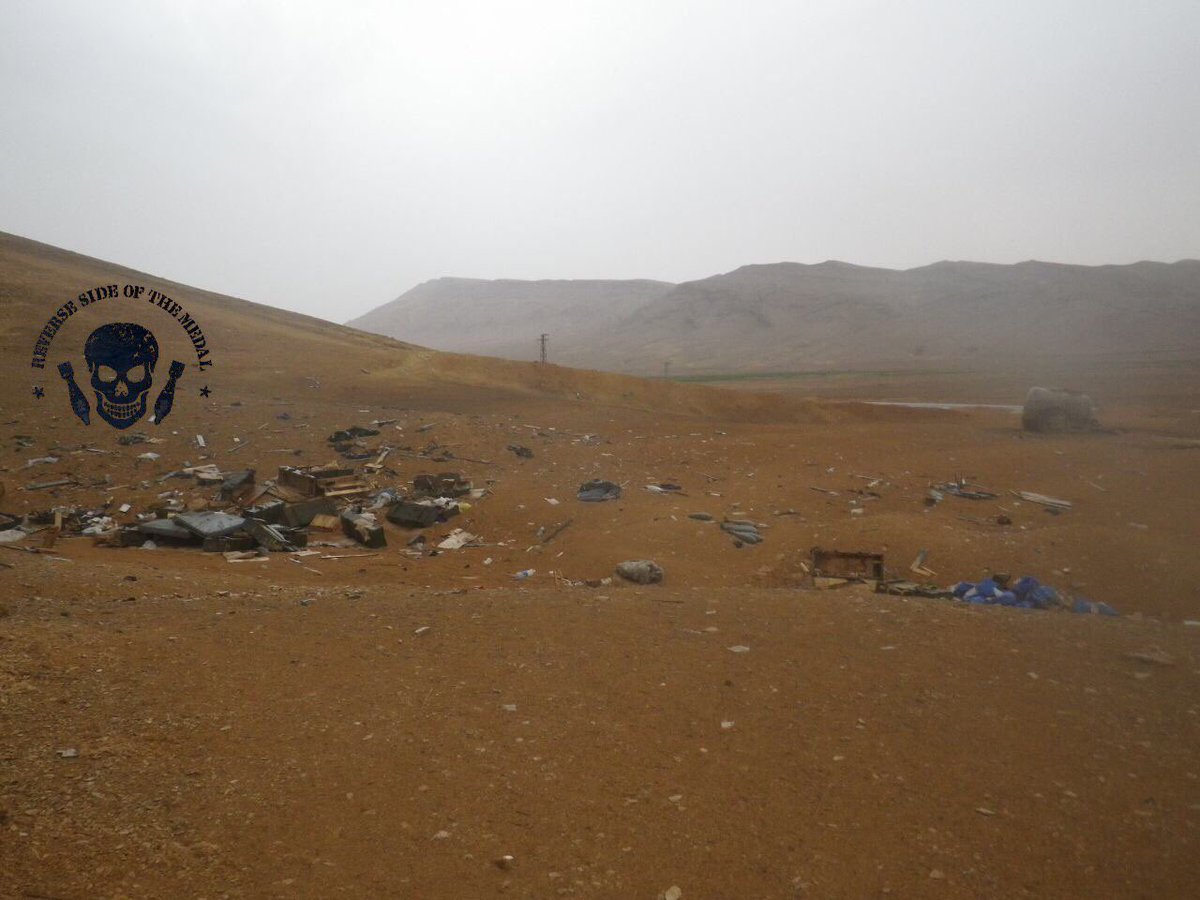
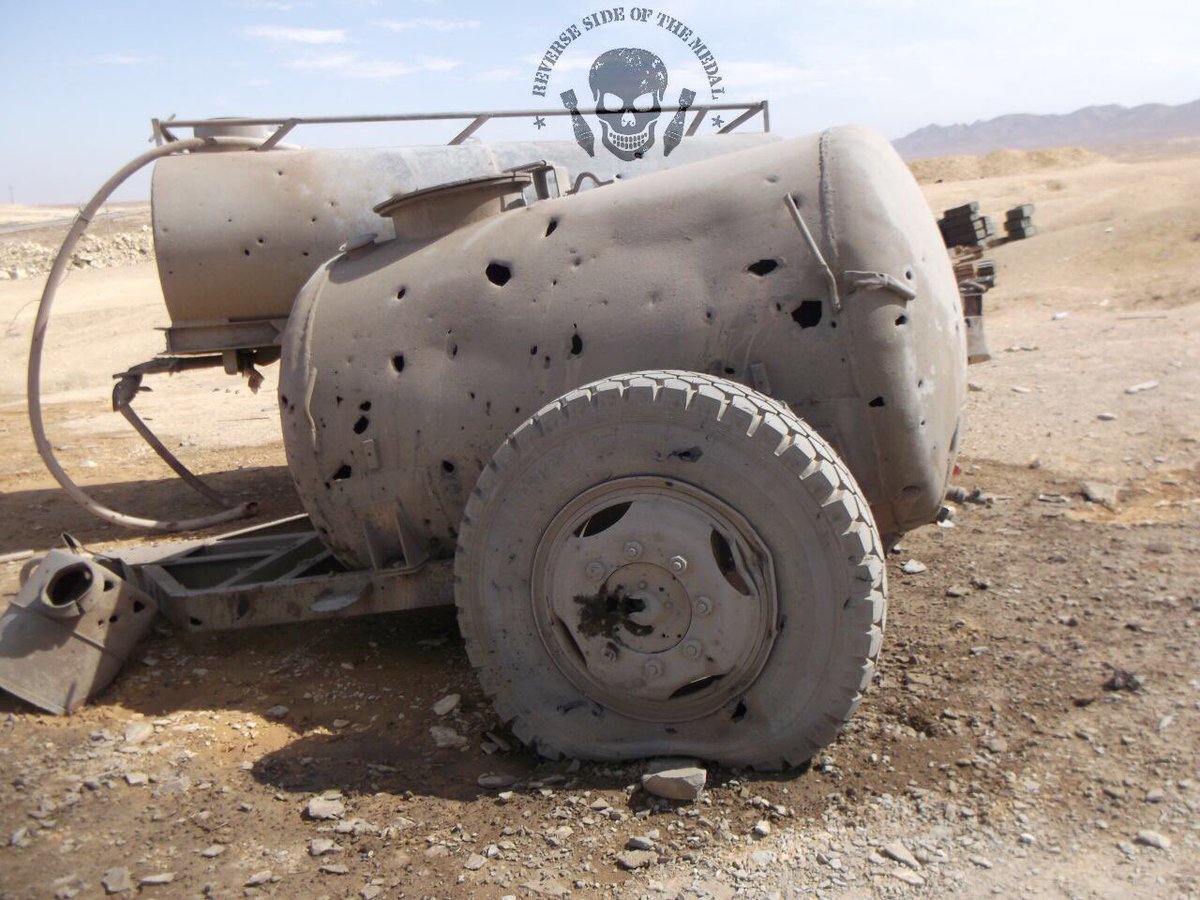
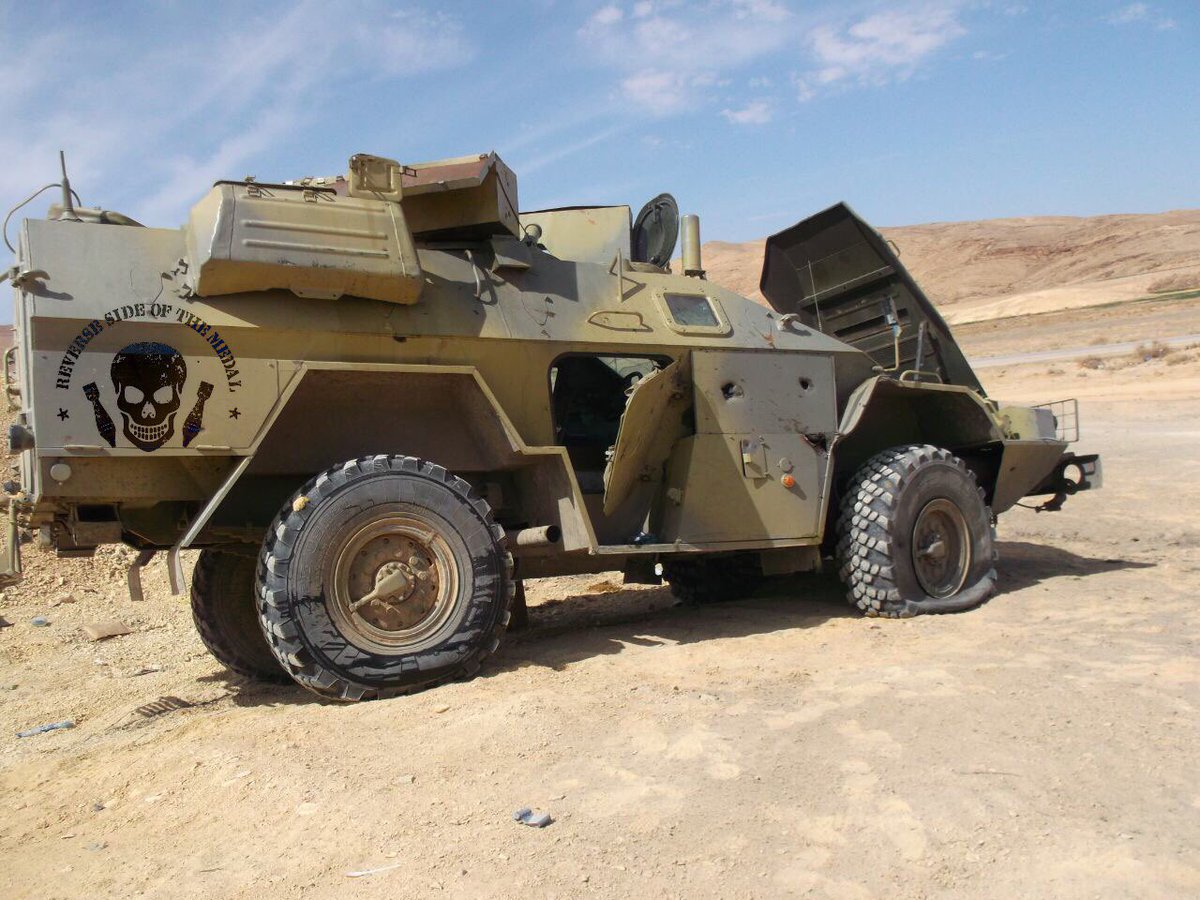
• • •
Missing some Tweet in this thread? You can try to
force a refresh






